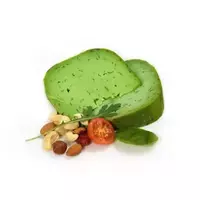Cheese green

Almost all countries of Europe have a rich and ancient tradition of cheese making. France, Germany and Italy are considered recognized leaders in this area. Another country is associated with high-quality cheeses and accurate watches - Switzerland.
The Swiss are famous for their love of cheese. Alpine inhabitants have a tradition of making Schabziger green cheese, which is produced only in the canton of Glarus. Green cheese is produced from milk, which is pre-degreased. Blue fenugreek is necessarily added to the milk, the resulting mixture is heated and citric or acetic acid is added.
Milk is folded and whey is formed, it is poured into special cone-shaped forms and stood for about a week. Then the green cheese must mature well, for this the cheese heads are suspended and allowed to dry (2-6 months). The longer the cheese matured, the richer and richer its taste and aroma. The cheese acquires its famous color as a result of mixing yellow milk mass and Blue fenugreek.
The original recipe for Swiss green cheese has changed in modern production and now the green color of the cheese is given not by the blue fenugreek, but also by the flowers of the Donnik plant. Green cheese has a brackish and slightly sharp savoury taste, has a pronounced cheese aroma.
Green cheese refers to fermented milk varieties of cheese. Interestingly, green cheese is packaged and sold in the form of already lost cheese, in a powder state and in cheese heads. Strikingly, green cheese was incredibly popular in the USSR. Cheese was sold in 20 gram paper bags, which cost 8 kopecks.
Green cheese as a powder is widely used in cooking. Green cheese is used to make sauces, add to pasta or omelette, sprinkle spaghetti, pasta or white bread toasted and grated with garlic on top. The composition of green cheese is replete with useful vitamins, minerals and trace elements. Green cheese contains magnesium, calcium, phosphorus, zinc, iron, as well as vitamins of groups A, B, C and E.
Green cheese is rich in healthy natural proteins and is almost carbohydrate-free. Nutritionists advise eating green cheese as a dietary product, even despite its calorie content (356 Kcal per 100 grams of product).
The greatest benefit of green cheese will be for older people and children who are actively developing. Doctors advise eating a piece of green cheese for patients with impaired appetite, it is believed that this product has the ability to arouse appetite. However, green cheese also has its own risk groups. If you suffer from gastritis or ulcer, and you were also strongly advised to refrain from eating salt, green cheese is contraindicated for you.
green cheese 355.6 kCal
The energy value of green cheese (Ratio of proteins, fats, carbohydrates - ju):
Proteins: 26 g (~ 104 kCal)
Fats: 26.5 g (~ 239 kCal)
Carbohydrates: 3.5 g (~ 14 kCal)
Energy ratio (bj | y): 29% | 67% | 4%
 Español
Español Français
Français Português
Português Русский
Русский 简体中文
简体中文 繁體中文
繁體中文 日本語
日本語 한국어
한국어 العربية
العربية Türkçe
Türkçe Қазақ
Қазақ Deutsch
Deutsch Italiano
Italiano Українська
Українська
